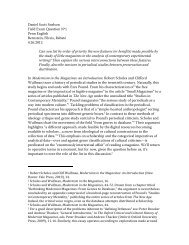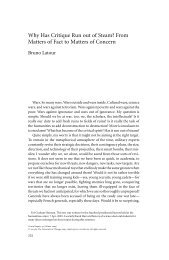The Exploit: A Theory of Networks - asounder
The Exploit: A Theory of Networks - asounder
The Exploit: A Theory of Networks - asounder
Create successful ePaper yourself
Turn your PDF publications into a flip-book with our unique Google optimized e-Paper software.
Coda 157<br />
ignored, and the network is imagined nonetheless. Accidents, failures,<br />
and exploits, both imaginative and material, are part and parcel <strong>of</strong><br />
any network. <strong>The</strong>se are strange and <strong>of</strong>ten bewildering kinds <strong>of</strong> accidents<br />
and failures—the accidents that are prescribed by the design,<br />
the failures that indicate perfect operation.<br />
<strong>Networks</strong> are elemental, in the sense that their dynamics operate<br />
at levels “above” and “below” that <strong>of</strong> the human subject. <strong>The</strong> elemental<br />
is this ambient aspect <strong>of</strong> networks, this environmental aspect—<br />
all the things that we as individuated human subjects or groups do<br />
not directly control or manipulate. <strong>The</strong> elemental is not “the natural,”<br />
however (a concept that we do not understand). <strong>The</strong> elemental<br />
concerns the variables and variability <strong>of</strong> scaling, from the micro level<br />
to the macro, the ways in which a network phenomenon can suddenly<br />
contract, with the most local action becoming a global pattern,<br />
and vice versa. <strong>The</strong> elemental requires us to elaborate an entire climatology<br />
<strong>of</strong> thought.<br />
<strong>The</strong> unhuman aspects <strong>of</strong> networks challenge us to think in an elemental<br />
fashion. <strong>The</strong> elemental is, in this sense, the most basic and the most complex<br />
expression <strong>of</strong> a network.<br />
As we’ve suggested in this book, networks involve a shift in scale,<br />
one in which the central concern is no longer the action <strong>of</strong> individuated<br />
agents or nodes in the network. Instead what matters more and<br />
more is the very distribution and dispersal <strong>of</strong> action throughout the network,<br />
a dispersal that would ask us to define networks less in terms <strong>of</strong><br />
the nodes and more in terms <strong>of</strong> the edges—or even in terms other than<br />
the entire, overly spatialized dichotomy <strong>of</strong> nodes and edges altogether.<br />
In a sense, therefore, our understanding <strong>of</strong> networks is all - too -<br />
human . ..









